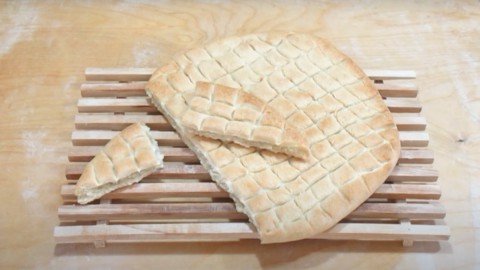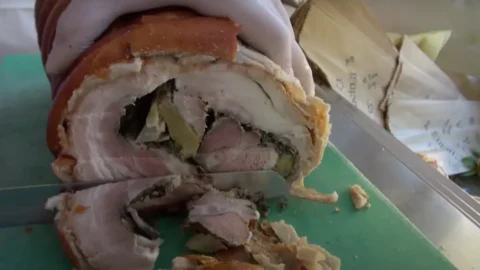Tasty, crunchy and easy to prepare. There monkey pizza is a Abruzzo specialty, an excellent substitute for bread, perfect for a snack or a quick lunch. The real surprise of this recipe is theabsence of yeast but at the base only flour, olive oil, dry white wine and a pinch of salt. A traditional "poor" dish but rich in flavour: it looks like a crumbly focaccia, characterized by diamond-shaped incisions to make it easier to break by hand. This Abruzzo specialty is reminiscent of other regional delicacies from central Italy, such as the Romagna piadina or the Umbrian torte al testo, but unlike these, scima pizza cannot be cut, it is broken!
A curious name but that has nothing to do with the preparation. Scima stands for "silly" and from which also derives the dialectal term "acime" which stands for unleavened, i.e. unleavened and which, over time, was transformed first into scime and then into scima. In the Chieti area it is known as pizza scima, while in L'Aquila as ascima and in Pescare pizza scive.
At one time, it was customary there cooking under the “tile“, a technique shared with Umbria and other regions of Central Italy. It is a kind of concave iron lid often equipped with a handle, with which the pizza is covered when placed inside a pan or baking tray and positioned on the floor of the hearths. Cooking under the tile made it possible to cook food slowly and evenly. Not only leavened products, but also meat and vegetables to give them crunchiness and an inviting aroma. Today, however, this technique is no longer used for purely hygienic reasons.
The origin of the scima pizza dates back to the late Middle Ages, in the first twenty years of the 1600s. Following a disastrous tidal wave that decimated the local populations, Abruzzo welcomed a vast Jewish community of families of artisans who had little familiarity with fishing and the sea. Thanks to ingenuity and cunning, they found a new way of fishing and thus the "trabocchi" were born, original fishing huts that still characterize the Abruzzo coast today. To these same families and to the unleavened bread we probably also owe the recipe for the scema pizza, a regional specialty still much loved today for its lightness. Excellent as an accompaniment to salads, cheeses, cured meats, soups or grilled meats such as arrosticini and other local specialties.
But what does unleavened bread mean for Jewish culture? During the Jewish Easter the people remember the liberation from slavery and it is not allowed to eat leavened bread because it recalls something old while Easter celebrates the new, the rebirth. Furthermore, leavening is also a symbol of corruption, as it improves the flavor and nutrition of wheat doughs but transforms them. Finally, a call to humility given that yeast makes the dough swell just as pride makes man's "heart" swell.
Scima pizza recipe
Ingredients
500 grams of 00 flour
75 grams of extra virgin olive oil
75 grams of water
100 grams of dry white wine (Cerasuolo or Trebbiano d'Abruzzo)
Salt to taste
Method
Proceed by mixing the flour with the white wine and the oil poured in slowly. Add a pinch of salt and work the dough until it is soft and smooth. At this point, cover the dough with transparent film and let it rest in the fridge for about 30 minutes. Meanwhile, grease a mold or line it with baking paper. After the necessary time has elapsed, roll out the dough to a thickness of about 1 and a half centimeters and make incisions on the entire surface with the tip of a knife. Then brush the focaccia with more olive oil and cook it in the oven at 200° for 20/25 minutes, until the surface is golden brown. It is advisable to cook the focaccia first on the lower level of the oven and then to raise it to cook the inside and brown the upper part. Serve at the table while still hot.





